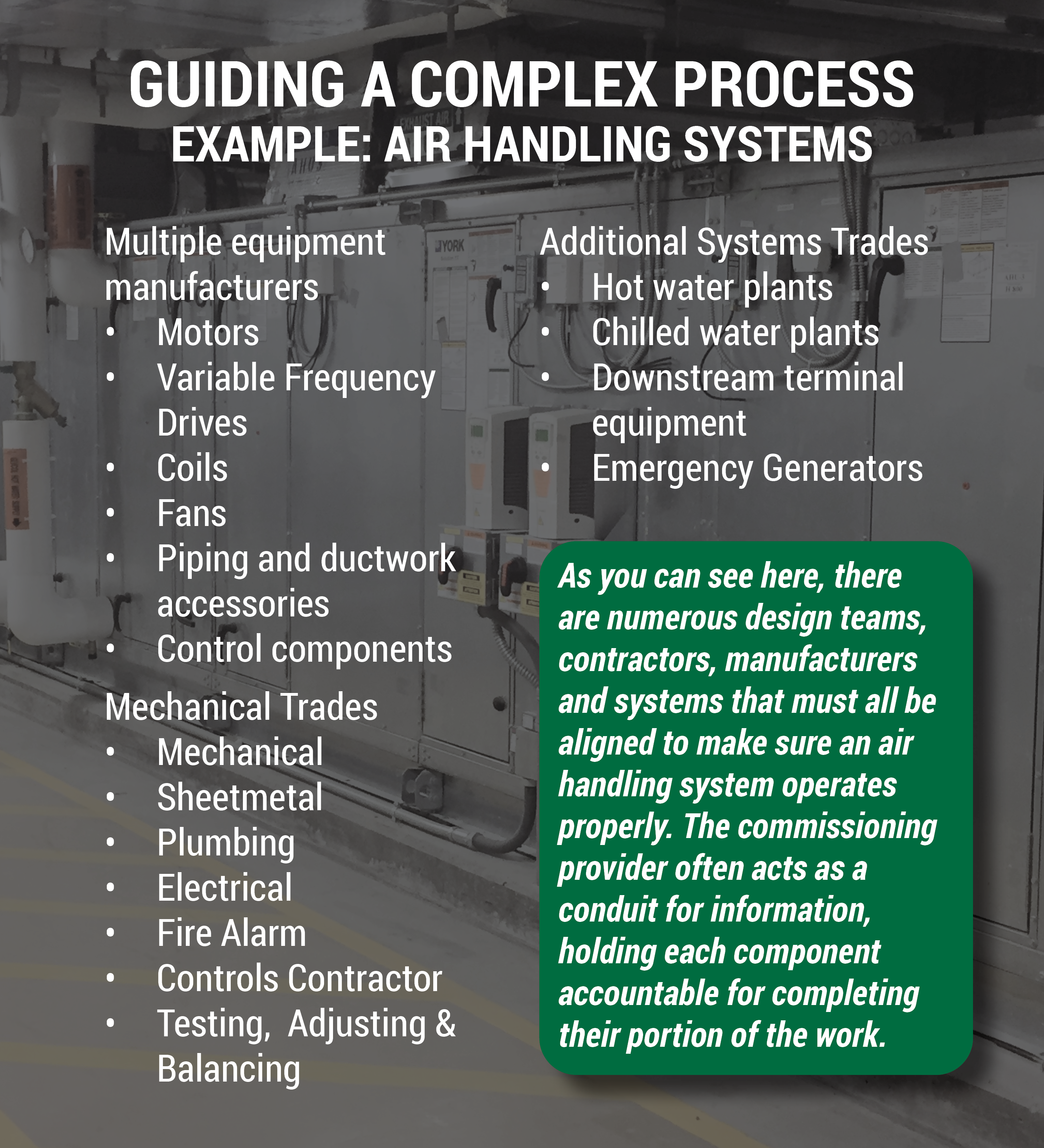Across the nation, various energy efficiency, sustainable and high performance programs require building commissioning to be incorporated into construction projects. Many national, state, and municipal codes also require commissioning. While engaging a design and construction team in a project is standard practice, commissioning still is often approached with ambiguity. Given how long commissioning has been around, it’s surprising how often we find the Owner asking, “what is commissioning? Why should I hire a commissioning provider?” We’ll answer these questions with a typical description of how commissioning is integrated into projects as they develop from the design stage, transition into construction, and conclude with turnover to the Owner.
In the modern age of high performance buildings, multiple people, trades, entities, and technologies are required to collaborate to design and construct these projects. While there are many different sectors and industries involved, they all typically operate in silos and are isolated to their specific niche. However, when a building is constructed and operated, these various systems and technologies must all work together. On the M/E/P side, you have various controls systems that must all communicate and work together (HVAC controls, lighting controls, emergency generator systems, domestic hot water systems, fire alarm systems, etc.). Even in building architecture, there are multiple components that must all tie together to maintain a continuous building envelope (roofing systems, window systems, air vapor barriers, etc.). Without seamless integration of all these components, the systems will not function as designed. A good commissioning agent knows how to identify problems, including coordination issues, early in the design stage. They will also help resolve issues that arise during construction and troubleshooting.
The commissioning provider will act as a technical liaison between the design team, construction team, and Owner’s team. Although each team has different technical backgrounds and experience, all parties need to have a mutual understanding of the design intent, constructability, and expectations in order to execute a successful project. A commissioning provider asks the hard questions and leads the conversation between coordinating and solving issues. Sometimes the initial design of a project may be great on paper, but the actual constructability may not be possible. Other times the construction may fail to meet the design requirements. And sometimes, the owner’s team needs help understanding the nature of the design and why it was pursued. In any case, the commissioning provider helps facilitate these discussions and ensures that a resolution is provided, no matter the cause.
 Building troubleshooting is arguably one of the most valuable components of commissioning. To illustrate this, let’s examine how an air handling system is built. First, a design team must work together to design the unit. The results of this engineering effort are drawings and specifications that communicate how the system is to be built and how it will perform. Then, multiple suppliers must manufacture the components of the system per the specifications. Once delivered to the site, a construction manager will oversee multiple subcontractors as they build the system from the components, connect the system to supporting equipment, connect power, and startup and finalize the system. During the startup, additional systems must be tied in, such as the hydronic plants and downstream terminal devices. To get to this point, the design team’s calculations rely on the building envelope being properly designed and installed in order for the unit to properly heat and cool the space. So, what happens if everything is complete and the spaces are uncomfortable? As you might imagine, there can be a lot of finger-pointing. As a true 3rd party team member, a commissioning provider can review and evaluate the design and construction throughout the process without bias. Sometimes a performance problem is caused by a single source; however, most of the time, multiple factors can affect the performance of a system. Regardless of the problem, a commissioning provider will be able to guide discussions and assist with navigating the team towards a resolution.
Building troubleshooting is arguably one of the most valuable components of commissioning. To illustrate this, let’s examine how an air handling system is built. First, a design team must work together to design the unit. The results of this engineering effort are drawings and specifications that communicate how the system is to be built and how it will perform. Then, multiple suppliers must manufacture the components of the system per the specifications. Once delivered to the site, a construction manager will oversee multiple subcontractors as they build the system from the components, connect the system to supporting equipment, connect power, and startup and finalize the system. During the startup, additional systems must be tied in, such as the hydronic plants and downstream terminal devices. To get to this point, the design team’s calculations rely on the building envelope being properly designed and installed in order for the unit to properly heat and cool the space. So, what happens if everything is complete and the spaces are uncomfortable? As you might imagine, there can be a lot of finger-pointing. As a true 3rd party team member, a commissioning provider can review and evaluate the design and construction throughout the process without bias. Sometimes a performance problem is caused by a single source; however, most of the time, multiple factors can affect the performance of a system. Regardless of the problem, a commissioning provider will be able to guide discussions and assist with navigating the team towards a resolution.
Building commissioning can consist of various activities and deliverables that span from the initial development of a project through the final turnover of the project. The reason for hiring a commissioning provider may differ depending on the Owner’s goals for the project. However, these services all have one common goal, to provide quality control over the course of the project and ensure that the building and the systems within it function according to the Owner’s needs.
It is worth noting that the commissioning process is only as valuable as the provider implementing it. To that point, commissioning is not a product, it is a service. As with every kind of service, the skills, experience, and results vary from provider to provider. The old saying “you get what you pay for” rings true when hiring a commissioning provider. Hiring an experienced, third-party commissioning provider will pay off invaluably over the course of the project. At Sustainable Engineering Solutions, we work diligently to not only provide a premier commissioning service but also educate and inform the Owner and the design and construction team throughout the process.
Contact us or click here to learn more about our commissioning services.

About the Author:
Brian Messerschmidt is a Project Manager at Sustainable Engineering Solutions. He has managed numerous Commissioning and Retro-Commissioning projects throughout Connecticut and Massachusetts. Brian earned his B.S. in Mechanical Engineering from Central Connecticut State University. He is a registered Professional Engineer in the State of Connecticut and a Certified Energy Manager.
